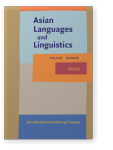Vol. 1:2 (2020) ► pp.278–308
From topic marker to case marker
A case of case formation in Gansu-Qinghai linguistic area
The case model of the syncretic case [xa] in the Gansu-Qinghai area came from non-Sinitic languages, while the phonetic form came from Sinitic languages (“Sinitic languages” are usually called “Chinese dialects” in the Chinese linguistic community). The paper shows that this marker [xa] may come from a topic marker and topic chain markers in Sinitic languages. The accusative/dative marker formation was motivated by pragmatic factors. This phenomenon is also found in other languages. The syncretic use of cases is commonplace in languages across the world, whereas the accusative/dative marker [xa] is one of the prominent features in Sinitic languages in the Gansu-Qinghai area. The accusative/dative case formation did not know an even speed in Sinitic languages. It seems that Wutun and Tangwang evolved rapidly while Linxia and Gangou changed with an intermediate rhythm. Qinghai languages are the closest to Tibetic languages, but paradoxically they seem to be more conservative and do not adopt dative markers in possessor and experiencer constructions which are seen overwhelmingly in Tibetic languages. However, other Sinitic languages have adopted this marking progressively and steadily. The language model of the syncretic marker [xa] is not from a single language. Amdo Tibetan as well as Mongolic languages have contributed to the case formation of [xa] in Sinitic languages. This paper proposes that an Intertwining Model helped the spread of case formation in this zone. Languages of one group or of one language family have influenced each other at different periods. The results of case formation we note today constitute a net-like relationships connected to various languages, but not a neat and linear path.
Article outline
- 1.Introduction
- 2.
acc/dat in languages and its syncretic feature
- 2.1From topic marker to case marker in other languages
- 2.2Syncretism of case marker
- 3.Topic and accusative/dative in the Gansu-Qinghai area
- 3.1Topic interpretation
- 3.2Double interpretation
- 3.3Accusative/dative coming from topic chain constructions
- 4.Dative marker in possessor and experiencer constructions
- 4.1 dat seen in poss constructions
- 4.2Dative marker seen in experience constructions
- 5.Concluding remarks: From which language did the Pattern replication spread?
- Acknowledgements
- Notes
- Abbreviations
-
References
